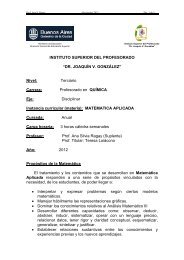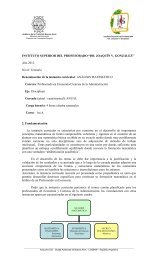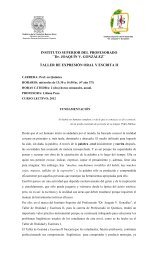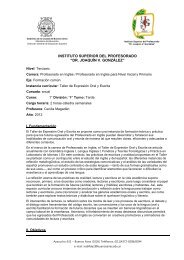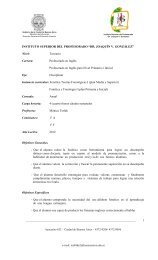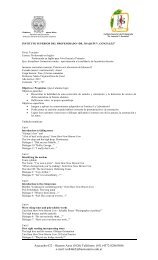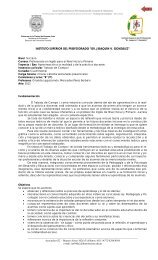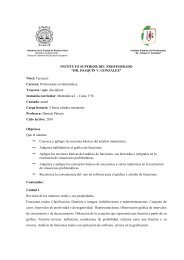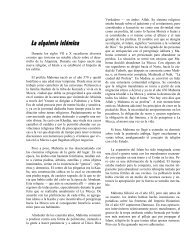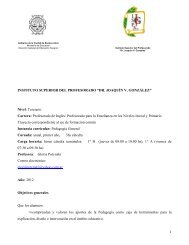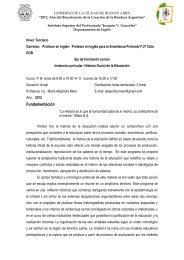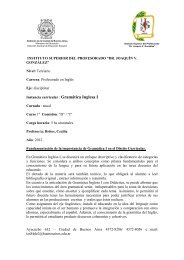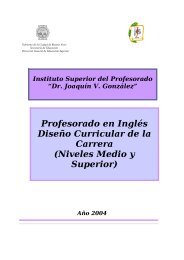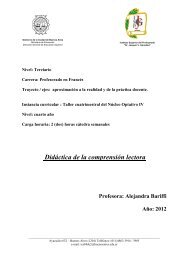Los retos de la historia oral en el siglo XXI: diversidades ...
Los retos de la historia oral en el siglo XXI: diversidades ...
Los retos de la historia oral en el siglo XXI: diversidades ...
You also want an ePaper? Increase the reach of your titles
YUMPU automatically turns print PDFs into web optimized ePapers that Google loves.
Sesiones parale<strong>la</strong>s / Parall<strong>el</strong> sessionstroupe’s arrest, who’s lived in a communal way in the city for three months,caused a great repercussion, inclusiv<strong>el</strong>y an international campaign for theirfreedom, <strong>en</strong>closed with their expulsion of the country. This fact was one of themilitary repression marks of the artistic and theatral c<strong>la</strong>ss, and specially of thecontraculture. The purpose of this work is to analyse the memory of the LivingTheatre passage through Ouro Preto. On the one hand, if libertine repres<strong>en</strong>tationsof artists’ lives and drugs use were caricatural remarkable on the pressof that time, on the other hand, the memories of esthetics innovations whichwere proposed by the group, their humanity and work with childr<strong>en</strong> from aworkm<strong>en</strong> quarter were <strong>en</strong>graved into people’s minds. The register and studyof these memories h<strong>el</strong>p us to un<strong>de</strong>rstand better the t<strong>en</strong>sions and impacts thatthe called contraculture everyday practices provoked in a conservative <strong>en</strong>vironm<strong>en</strong>tsuch as Ouro Preto, in a totally military dictatorship, as w<strong>el</strong>l as theapproximation betwe<strong>en</strong> part of the youth and local artists, p<strong>la</strong>cing them asicons of dictatorship and conservativ<strong>en</strong>ess rejection.El Estado autoritario brasileño, bajo <strong>el</strong> régim<strong>en</strong> militar (1964-1984), reprimió ypersiguió no sólo a <strong>la</strong>s izquierdas (comunistas, socialistas, etc), sino también<strong>la</strong>s manifestaciones sociales, estéticas y políticas <strong>de</strong> <strong>la</strong> l<strong>la</strong>mada contracultura,vista <strong>en</strong> <strong>el</strong> imaginario <strong>de</strong> <strong>la</strong> extrema <strong>de</strong>recha como un “comunismo invisible”con <strong>la</strong> misión <strong>de</strong> <strong>de</strong>struir <strong>la</strong> familia y <strong>la</strong> tradición cristiana, lo que permitiría <strong>el</strong>surgimi<strong>en</strong>to <strong>de</strong> un régim<strong>en</strong> moscovita. En este contexto, <strong>en</strong> 1971, ocurrió <strong>la</strong> prisión<strong>de</strong> los miembros <strong>de</strong>l conceptuado grupo Living Theatre, los pioneros <strong>de</strong>lteatro off-Broadway, cuando se preparaban para participar <strong>de</strong>l Festival <strong>de</strong> Invierno<strong>de</strong> Ouro Preto, <strong>en</strong> <strong>la</strong> provincia <strong>de</strong> Minas Gerais. La <strong>de</strong>t<strong>en</strong>ción <strong>de</strong> <strong>la</strong> compañía,que vivía <strong>de</strong> forma comunal <strong>en</strong> <strong>la</strong> ciudad minera t<strong>en</strong>ía tres meses, causógran repercusión, incluy<strong>en</strong>do una campaña internacional para su liberación,que terminó con su expulsión <strong>de</strong>l país. Este hecho fue un marco <strong>en</strong> <strong>la</strong> represión<strong>de</strong> los militares a <strong>la</strong> c<strong>la</strong>se artística y teatral y <strong>en</strong> particu<strong>la</strong>r a <strong>la</strong> contracultura.El objetivo <strong>de</strong> esta investigación es analizar <strong>la</strong>s memorias <strong>de</strong> los resi<strong>de</strong>ntes <strong>de</strong>Ouro Preto sobre <strong>el</strong> paso <strong>de</strong>l Living Theatre por <strong>la</strong> ciudad y <strong>la</strong>s repres<strong>en</strong>tacionesque figuran <strong>en</strong> él. Si, por un <strong>la</strong>do, son recurr<strong>en</strong>tes <strong>la</strong>s repres<strong>en</strong>taciones, <strong>de</strong>forma caricatural, <strong>de</strong> una vida libertina <strong>de</strong> los artistas y <strong>el</strong> uso <strong>de</strong> drogas, por<strong>el</strong> otro, se registran, junto con estos, los recuerdos <strong>de</strong>l humanismo <strong>de</strong>l grupo y<strong>el</strong> trabajo que realizó con los niños <strong>de</strong> un barrio <strong>de</strong> c<strong>la</strong>se obrera. El registro y <strong>la</strong>análisis <strong>de</strong> estos recuerdos nos ayudan a compr<strong>en</strong><strong>de</strong>r mejor <strong>la</strong>s t<strong>en</strong>siones y loschoques que <strong>la</strong>s prácticas cotidianas <strong>de</strong> <strong>la</strong> l<strong>la</strong>mada contracultura provocaban<strong>en</strong> un ambi<strong>en</strong>te conservador como Ouro Preto, <strong>en</strong> pl<strong>en</strong>a dictadura militar, y <strong>la</strong>aproximación <strong>de</strong> parte <strong>de</strong> los jóv<strong>en</strong>es y artistas locales a <strong>el</strong> grupo, poni<strong>en</strong>do <strong>el</strong>Living Theatre como icono <strong>de</strong>l rechazo a <strong>la</strong> dictadura y a <strong>el</strong> conservadurismo.BRANCHER, AnaLa literatura y <strong>la</strong> resist<strong>en</strong>cia. Cinco escritoras <strong>de</strong>l ConoSurEn difer<strong>en</strong>tes mom<strong>en</strong>tos <strong>de</strong> <strong>la</strong> <strong>historia</strong>, <strong>la</strong>s escritoras <strong>la</strong>tinoamericanas, o porlo m<strong>en</strong>os algunas <strong>de</strong> <strong>el</strong><strong>la</strong>s, han <strong>de</strong>mostrado un <strong>de</strong>sempeño eficaz <strong>en</strong> los esc<strong>en</strong>arios<strong>de</strong> <strong>la</strong> política adoptada por sus gobiernos, ya sea <strong>en</strong> <strong>la</strong> actividad literaria<strong>en</strong> sí mismo (es <strong>de</strong>cir, <strong>la</strong> publicación <strong>de</strong> <strong>la</strong>s nove<strong>la</strong>s), ya sea cubrir puestos públicoscomo diputadas, asesoras, diplomáticas, profesoras, como articu<strong>la</strong>doras<strong>de</strong> <strong>la</strong>s marchas, confer<strong>en</strong>cias, manifiestos, revistas, asociaciones.La pres<strong>en</strong>te Comunicación examina <strong>el</strong> diálogo <strong>en</strong>tre <strong>el</strong> campo literario y político,t<strong>en</strong>i<strong>en</strong>do como trazado <strong>de</strong> recorte cinco escritoras <strong>de</strong>l Cono Sur, sus trabajosescritos o publicados durante <strong>la</strong>s dictaduras o que ti<strong>en</strong><strong>en</strong> <strong>el</strong> período comotema, así como su pap<strong>el</strong> <strong>en</strong> <strong>el</strong> proceso <strong>de</strong> <strong>la</strong> <strong>de</strong>mocratización <strong>de</strong> sus países. Lasdictaduras civiles y militares que se han as<strong>en</strong>tado <strong>en</strong> <strong>el</strong> Cono Sur <strong>en</strong>tre 1950y 1990, aproximadam<strong>en</strong>te, interrumpieran los procesos <strong>de</strong> mo<strong>de</strong>rnizacióny <strong>de</strong>mocratización <strong>de</strong> <strong>la</strong> región. Una <strong>de</strong> <strong>la</strong>s primeras medidas adoptadas porlos gobiernos dictatoriales fue “sil<strong>en</strong>ciar” a <strong>la</strong> g<strong>en</strong>te que estaba <strong>en</strong> contra losnuevos esquemas, lo que significó <strong>la</strong> <strong>el</strong>iminación <strong>de</strong> los proyectos políticos <strong>de</strong>g<strong>en</strong>eraciones <strong>en</strong>teras <strong>de</strong> difer<strong>en</strong>tes categorías y c<strong>la</strong>ses sociales. Miles <strong>de</strong> obreros,campesinos, maestros, estudiantes, artistas, políticos fueron arrestados,torturados, exiliados, asesinados. La c<strong>en</strong>sura <strong>de</strong> <strong>la</strong>s obras <strong>de</strong> arte y los artistasera una práctica habitual. Al mismo tiempo que se insta<strong>la</strong>ba <strong>en</strong> estas prácticasrepresivas, <strong>el</strong> terrorismo <strong>de</strong> Estado llevó a <strong>la</strong> resist<strong>en</strong>cia <strong>de</strong> estas categorías.En <strong>el</strong> contexto <strong>de</strong>scrito, <strong>la</strong>s discusiones teóricas y <strong>en</strong>foques metodológicosalim<strong>en</strong>tados por <strong>el</strong> canal <strong>de</strong> <strong>la</strong> <strong>historia</strong> <strong>oral</strong> permit<strong>en</strong> una interpretación <strong>de</strong> <strong>la</strong><strong>historia</strong> reci<strong>en</strong>te, <strong>la</strong>s <strong>de</strong>fici<strong>en</strong>cias todavía <strong>en</strong>ormes <strong>en</strong> <strong>la</strong> historiografía <strong>de</strong> AméricaLatina.CRISTERNA SÁNCHEZ, ArturoHistoria <strong>de</strong> vida <strong>de</strong> <strong>la</strong> artista plástica Nina Mor<strong>en</strong>oLa ciudad <strong>de</strong> Tijuana, México, ha sido objeto <strong>de</strong> innumerables estudios sociológicos<strong>de</strong>bido a los f<strong>en</strong>óm<strong>en</strong>os sociales que <strong>en</strong> esta ciudad se han v<strong>en</strong>ido <strong>de</strong>sarrol<strong>la</strong>ndo<strong>en</strong> <strong>la</strong>s últimas décadas, sobre todo <strong>en</strong> lo que respecta a migración.Dichos estudios han sido muy ricos <strong>en</strong> lo que concierne a f<strong>en</strong>óm<strong>en</strong>os migratorios<strong>en</strong> <strong>el</strong> que intervi<strong>en</strong><strong>en</strong> migrantes <strong>de</strong> escasos recursos, muchos <strong>de</strong> los cualesvi<strong>en</strong><strong>en</strong> a Tijuana con <strong>el</strong> propósito <strong>de</strong> cruzar <strong>la</strong> frontera política <strong>en</strong>tre México yEstados Unidos.Sin embargo, exist<strong>en</strong> otros actores sociales cuya <strong>historia</strong> reve<strong>la</strong> otro tipo <strong>de</strong>migración, y cuyo estudio expone i<strong>de</strong>ntida<strong>de</strong>s distintas <strong>de</strong> aqu<strong>el</strong>los grupos, ei<strong>de</strong>as difer<strong>en</strong>tes sobre su lugar <strong>de</strong> orig<strong>en</strong> y sobre Tijuana. Tal es <strong>el</strong> caso <strong>de</strong> <strong>la</strong> artistaplástica Nina Mor<strong>en</strong>o Pastrana, cuya <strong>historia</strong> a continuación se cu<strong>en</strong>ta através <strong>de</strong> su propio testimonio y <strong>de</strong> <strong>la</strong> <strong>historia</strong> <strong>de</strong> ciertos lugares que influyeron<strong>en</strong> su vida privada y <strong>en</strong> su trayectoria artística.The bor<strong>de</strong>r city of Tijuana, Mexico, has be<strong>en</strong> the focus of many sociologic studies,due to the social ph<strong>en</strong>om<strong>en</strong>a that has be<strong>en</strong> <strong>de</strong>v<strong>el</strong>oping in the city throughoutthe <strong>la</strong>st <strong>de</strong>ca<strong>de</strong>s, being migration the main subject in almost all of them.Said studies have be<strong>en</strong> very successful in illustrating migration ph<strong>en</strong>om<strong>en</strong>ain which poor migrants interv<strong>en</strong>e, many of whom come to Tijuana in hopes ofcrossing the barrier that divi<strong>de</strong>s Mexico from the United States.Neverth<strong>el</strong>ess, there are other social actors who’s lives reveal other forms ofmigration that wh<strong>en</strong> studied exposes another kind of i<strong>de</strong>ntity and differ<strong>en</strong>ti<strong>de</strong>as about Tijuana and the p<strong>la</strong>ce they left behind. That is the case of visua<strong>la</strong>rtist Nina Mor<strong>en</strong>o Pastrana, whose history is told in this paper through hisown testimony and the history of the p<strong>la</strong>ces that have influ<strong>en</strong>ced her privat<strong>el</strong>ife and her artistic career.BATISTA, Juliana W<strong>en</strong>dpapMúsica e <strong>historia</strong> <strong>en</strong> <strong>la</strong>s canciones <strong>de</strong>l LP “C<strong>la</strong>ra Crocodilo”<strong>de</strong> Arrigo Barnabé: análisis <strong>de</strong>l contexto socialy cultural <strong>en</strong> los años 1970 y 1980The composer from Paraná Arrigo Barnabé is consi<strong>de</strong>red one of the mainrepres<strong>en</strong>tatives of Paulistana Vanguard. This was an act time that becameknown in the 1980s for the aesthetic stance of r<strong>en</strong>ewing its musicians. ArrigoBarnabé received att<strong>en</strong>tion to have be<strong>en</strong> appointed as the first composer touse the techniques of serial music in the production of popu<strong>la</strong>r music. In 1980,the r<strong>el</strong>ease of his LP C<strong>la</strong>ra Crocodilo had a powerful impact on the urban <strong>la</strong>ndscapeof brazilian popu<strong>la</strong>r music. The fact offered praise and led him for beingconsi<strong>de</strong>red by the press as the great new post-tropicalia. For the production ofC<strong>la</strong>ra Crocodilo, Arrigo Barnabé used wi<strong>de</strong>ly serial music, and characters of hissongs, thematizing the adv<strong>en</strong>tures of an office boy transformed into a hybridmonster, were inspired by comic books. Therefore, the proposal for this communicationis to establish a dialogue betwe<strong>en</strong> music and history, specificallythe re<strong>la</strong>tionship betwe<strong>en</strong> the work of the composer Arrigo Barnabé and culturalprocess and social policy that are re<strong>la</strong>ted on it. In this s<strong>en</strong>se we int<strong>en</strong>d,through an analysis of <strong>oral</strong> narrative and the recurr<strong>en</strong>ce of the composer in hisspeech, evaluate the positioning of the front of the same artistic possibilitiesof action living in the system of military civilian dictatorship in Brazil, consi<strong>de</strong>ringthat the eight songs of C<strong>la</strong>ra Crocodilo were composed betwe<strong>en</strong> 1972and 1980. The sources to be used inclu<strong>de</strong> newspaper clippings and magazines,the Lp in question, and an <strong>oral</strong> interview conducted with Arrigo Barnabé. Thisresearch is part of the study that is being <strong>de</strong>v<strong>el</strong>oped from the project “SerialMusic and Popu<strong>la</strong>r Music - Arrigo Barnabé in the context of the 1970 and 1980:History and Art pres<strong>en</strong>t in the social perception of the composer through of theC<strong>la</strong>ra Crocodilo LP” in the master program in History of PUCRS.Santhiago, RicardoOral history and the arts: A review of the BrazilianliteratureAfter carrying out a number of research using <strong>oral</strong> narratives in the study ofBrazilian art history, focusing particu<strong>la</strong>rly Brazilian popu<strong>la</strong>r music, I have be<strong>en</strong><strong>de</strong>v<strong>el</strong>oping a project on the history of <strong>oral</strong> history in Brazil, from the perspectiveof int<strong>el</strong>lectual history. In this paper, I put both themes together, performinga survey and a critical analysis of Brazilian scho<strong>la</strong>rly work, in the fi<strong>el</strong>d of <strong>oral</strong>history, on the memory of artists, cultural movem<strong>en</strong>ts and creative practices.As we know, <strong>oral</strong> histories have be<strong>en</strong> wi<strong>de</strong>ly used in this sort of studies. In thisliterature review, I will consi<strong>de</strong>r works on: 1. Artists and collectives of artistsin their differ<strong>en</strong>t fi<strong>el</strong>ds: music, literature, visual arts, dance, circus, digital art,cinema, theater; 2. Artistic movem<strong>en</strong>ts and their mom<strong>en</strong>ts; 3. Cultural expressions,in a broad range of analytical frameworks (popu<strong>la</strong>r culture, high culture,mass culture, etc.); 4. Systematic use of <strong>oral</strong> accounts on research on creativeprocess, connected with other tools such as the so-called “g<strong>en</strong>etic criticism”.This collection of works will be analyzed according to: the methodologicalperspective used in gathering and interpreting <strong>oral</strong> sources; topics and periodscovered; theoretical positions governing the choice of subject and the46



